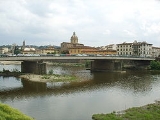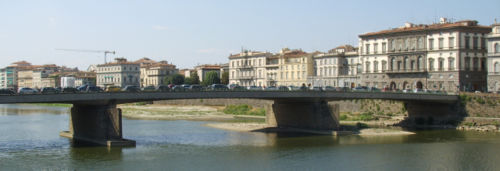
Ponte Amerigo Vespucci
Encyclopedia
Ponte Amerigo Vespucci is a bridge
over the Arno River in Florence
, Italy
and named after Florence-born explorer Amerigo Vespucci
. It joins the Lungarno Amerigo Vespucci to the Lungarno Soderini. To the east is the Ponte alla Carraia
.
This bridge, like most of the other bridges over the Arno, is a reconstruction. Plans were made in 1908 to bridge this section of the Arno to service quartiere di San Frediano, but the plans were never realized. In 1949, a bridge, ponte di via Melegnano, was constructed from the recycled remains of other bridges that had been destroyed by the Nazi army
as they withdrew before the advancing Allied forces
during World War II
.
Between 1952 and 1954, a competition for the construction of a new bridge was held, and the plan of the architects George Giuseppe Gori, Enzo Gori and Ernesto Nelli and of engineer Riccardo Morandi
was chosen. The plan called for three span
s in a thin, flat arch
over two pier
s which supports the roadway. The final effect gives the impression of a single, slightly curved span. Construction on the bridge was completed in 1957.
It was designed to be reflective of the nearby historical structures but also to be an obviously modern structure.

Bridge
A bridge is a structure built to span physical obstacles such as a body of water, valley, or road, for the purpose of providing passage over the obstacle...
over the Arno River in Florence
Florence
Florence is the capital city of the Italian region of Tuscany and of the province of Florence. It is the most populous city in Tuscany, with approximately 370,000 inhabitants, expanding to over 1.5 million in the metropolitan area....
, Italy
Italy
Italy , officially the Italian Republic languages]] under the European Charter for Regional or Minority Languages. In each of these, Italy's official name is as follows:;;;;;;;;), is a unitary parliamentary republic in South-Central Europe. To the north it borders France, Switzerland, Austria and...
and named after Florence-born explorer Amerigo Vespucci
Amerigo Vespucci
Amerigo Vespucci was an Italian explorer, financier, navigator and cartographer. The Americas are generally believed to have derived their name from the feminized Latin version of his first name.-Expeditions:...
. It joins the Lungarno Amerigo Vespucci to the Lungarno Soderini. To the east is the Ponte alla Carraia
Ponte alla Carraia
The Ponte alla Carraia is a five-arched bridge spanning the River Arno and linking the district of Oltrarno to the rest of the city of Florence, Italy. To the west is a weir, the Pescaia di Santa Rosa, and the Ponte Amerigo Vespucci, and to the east is the Ponte Santa Trinita. The piazzas on either...
.
This bridge, like most of the other bridges over the Arno, is a reconstruction. Plans were made in 1908 to bridge this section of the Arno to service quartiere di San Frediano, but the plans were never realized. In 1949, a bridge, ponte di via Melegnano, was constructed from the recycled remains of other bridges that had been destroyed by the Nazi army
Wehrmacht
The Wehrmacht – from , to defend and , the might/power) were the unified armed forces of Nazi Germany from 1935 to 1945. It consisted of the Heer , the Kriegsmarine and the Luftwaffe .-Origin and use of the term:...
as they withdrew before the advancing Allied forces
Allies of World War II
The Allies of World War II were the countries that opposed the Axis powers during the Second World War . Former Axis states contributing to the Allied victory are not considered Allied states...
during World War II
World War II
World War II, or the Second World War , was a global conflict lasting from 1939 to 1945, involving most of the world's nations—including all of the great powers—eventually forming two opposing military alliances: the Allies and the Axis...
.
Between 1952 and 1954, a competition for the construction of a new bridge was held, and the plan of the architects George Giuseppe Gori, Enzo Gori and Ernesto Nelli and of engineer Riccardo Morandi
Riccardo Morandi
Riccardo Morandi was an Italian civil engineer best known for his interesting use of reinforced concrete. Amongst his best known works were the General Rafael Urdaneta Bridge, an 8 km crossing of Lake Maracaibo incorporating seven cable-stayed bridge spans with unusual piers, and the...
was chosen. The plan called for three span
Span (architecture)
Span is the distance between two intermediate supports for a structure, e.g. a beam or a bridge.A span can be closed by a solid beam or of a rope...
s in a thin, flat arch
Arch
An arch is a structure that spans a space and supports a load. Arches appeared as early as the 2nd millennium BC in Mesopotamian brick architecture and their systematic use started with the Ancient Romans who were the first to apply the technique to a wide range of structures.-Technical aspects:The...
over two pier
Pier (architecture)
In architecture, a pier is an upright support for a superstructure, such as an arch or bridge. Sections of wall between openings function as piers. The simplest cross section of the pier is square, or rectangular, although other shapes are also common, such as the richly articulated piers of Donato...
s which supports the roadway. The final effect gives the impression of a single, slightly curved span. Construction on the bridge was completed in 1957.
It was designed to be reflective of the nearby historical structures but also to be an obviously modern structure.


